Moorgate station serves the Circle, Metropolitan, Hammersmith and City and the Northern lines as well as a main line rail service to Stevenage.
On the 28th February 1975 the single worst peacetime accident on the underground took place at this station.. 43 people died and 74 were injured. A southbound Northern City Line train from Drayton Park carrying 300 people failed to stop at the platform and ploughed into the sand-drag (intended to slow trains which had failed to stop), hitting the buffer stop and crashing into the concrete wall at the end of the tunnel. When rescuers reached the platform they found the front three carriages had been crushed together. The investigation that followed could find no fault with the train nor any health related problem with the driver whose body was the last to be recovered.
Following the disaster London Transport introduced a permanent 10mph speed limit on all trains entering 'dead end' passenger locations. In 1978 a system called 'Moorgate Protection' was introduced, which automatically applied the brakes if the driver failed to do so.
The station has three different exits I took the one onto Moorgate. The building to the right of the exit was once the head office of the City and South London railway. Above the entrance is a relief panel showing two trains going into a tunnel. There are two shields, the one on the left is the City of London whilst the other one is used to identify bridges and property belonging to the Bridge House Trust.

I turned left and walked the few hundred metres past large buildings and shops to Finsbury Square.
It is here that a memorial to the Moorgate disaster was erected in 2013. Not sure why it took so long before this memorial was commissioned. To me it seems a very impersonal memorial with names listed, surname first.

Triton Court is composed of three buildings: Mercury, Jupiter and Neptune. A major refurbishment and extension combined the buildings in 1984. The outside is decorated with carvings and statues depicting ancient gods.

Two bronze statues of Titon stand either side of the entrance.
The highest spire is topped with a bronze statue of Mercury standing on a globe.
In 1955 Finsbury council acquired the square and created a public garden with flowerbeds, bowling green, changing rooms and a refreshment house.
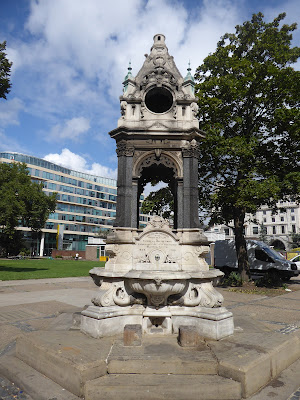
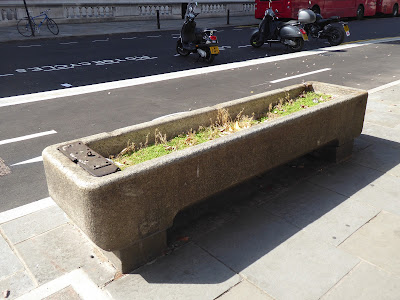
City Gate House on the opposite side of the square to Titon Court. The building was constructed in the 1930s and was designed as a 'Members' club' by Frederick Gould and George Gilbert Scott, designer of the iconic red phone booths
I returned from Finsbury square in the direction of the station and turned left off Moorgate to Finsbury Circus.
The moor on the site was drained in 1527 and gravelled walks were laid out across the open fields. By the mid 17th century the southern part had been laid out with more formal walks. In 1675 Bethlehem Royal Hospital was re-sited in buildings at the end of Moor field. It was only when this was demolished in 1815 that the Circus (from the Latin word meaning circle or ring) was started. The oval shaped gardens surrounded by elegant curved terraces were laid out in 1815-17 .


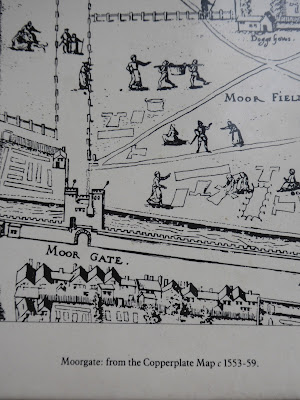
In 1415 it was totally rebuilt and the engraving shows it as a single gate flanked by towers. The copperplate maps and engraving can be seen in the London Museum just down the road from here.
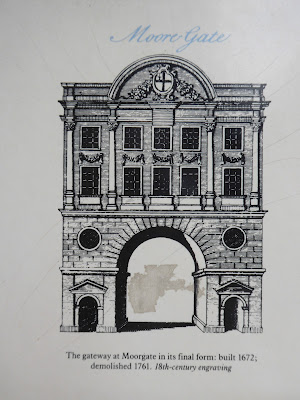
In 1672 Moorgate was rebuilt as an imposing ceremonial entrance. This was demolished in 1761 to improve traffic access.
On the opposite corner is the pub ' Keats at the Globe'. Outside the pub is a brass plaque with the following information engraved on it:
The Globe is an old and popular pub name and was established during the reign of Charles I . As a symbol the Globe has historically been an emblem of Portugal and was used to advertise that Portugese drinks were on sale. The pub is situated on Moorgate, the name of which was derived from the barren wetlands outside the City wall called Moorfields and the junction of London Wall that ran along the line of the Roman wall that once encircled the City. John Keats was born at Moorgate in 1795. His first work was published in 1817 and attracted some favourable attention. He is best known for his peom 'Ode to a nightingale'.
I continued my walk South along Moorgate and noticed some interesting nautical details on the Habib Bank AG Zurich building.
 |

Following the building round through the alley way there are more clues to its original purpose.
A ship's prow

The name of the building above the arched doorway. The original inhabitants 'The Ocean Accident and Guarantee Corporation Ltd' had its headquarters here from 1893 to 1966. The building was rebuilt during 1924-28 by Sir Aston Webb and son. The archway from Moorgate had led me into Great Swan Alley where there was another remarkable building.
This ornate building is the Institute of Chartered Accountants. In 1880 a Royal Charter was granted and the various Accountancy Associations merged together to form the Institute of Chartered Accountants in England and Wales. It was clear that new premises were needed and six of Britain's leading architects were invited to compete to design a new building in Moorgate Place.

Groups of figures represent the arts, science,crafts and so on. Another section represents the stages in the construction process from surveyor to solicitor.
I returned to Moorgate via King's Arms Yard and noticed this ornate building on the opposite corner. Now the Europe Arab Bank as well as other companies, this building at 13-15 Moorgate used to be the Metropolitan Life Assurance building. Built 1890-93, it is decorated with architectural sculptures. The statues are named: Confidence, Prudence, Justice, Truth, Thrift and Self-denial. I'm not sure to whom these virtues apply especially thrift and self-denial.

I continued my walk back up Moorgate turning left on Great Bell Alley enticed by the name. However there was nothing great or worth mentioning about the alley. It did lead me onto Mason's Avenue though which was more interesting.
On Mason's Avenue is the Old Dr Butler's Head, one of several pubs founded around 1616 to sell a successful brand of medicinal ale made by Dr Butler and known as Dr Butler's purging ale. Dr Butler was the King's physician. He specialised in the shock method of treatment and once 'cured' a patient by having him thrown out of a window into the Thames. Radical and one to avoid I would say.
I continued to the end of Mason's Avenue and came out on Basinghall Street. Turn left here and then first right into the Guildhall Yard.
On the right is the Guildhall, greatly repaired after the Fire of London and WW2 damage.
This is the modern walkway that leads into the medieval Guildhall.
The Guildhall is in the centre of the City of London and has been the powerhouse of the City since the twelfth century. It was here that the Lord Mayor of London and the ruling merchant class held court, ensured that the law and trading regulations kept up with their needs to create London's wealth. Today the Guildhall is still the home of the City of London Corporation and is used for banquets in honour of visiting Heads of State and Royal occasions.
It was built between 1411 and 1440 and designed to reflect the importance of London. If there is no function taking place the public can go in and have a look round the Great Hall. On the day I visited there was no-one else there and I had this magnificent hall all to myself. I have no doubt that I was being watched by numerous cameras but I could still enjoy the moment of having this magnificent place all to myself.
A gruesome list of the outcome of some of the trials held here.
Looking up you can see the coat of arms of the City of London and the Livery Companies as well as those of important families. The 12 companies making up the guilds of London are : Clothworkers, Drapers, Fishmongers, Goldsmiths, Grocers, Haberdashers, Ironmongers, Mercers, Merchant Taylors, Salters, Skinners and Vintners.

The Guildhall was damaged in the Great Fire of 1666 and in WW2. so much has been renovated and rebuilt over the years including the windows. The windows are dedicated to English Monarchs.
Overlooking the Hall are the statues of the legendary giants Gog and Magog. The original statues were destroyed by enemy action in 1940 but replaced in 1953. They represent the conflict between ancient Britons and Trojan invaders.
 Roman discoveries are still being made as archaeologists must excavate an area before any new construction within the City of London can begin. In 1988 Museum of London archaeologists discovered the site of an amphitheatre beneath the Guildhall Yard. It was built in 70AD as a wooden structure but was restructured in the 2nd century to accommodate 6000 spectators. After the Romans left Britain in the 4th Century the amphitheatre was dismantled and the stone used for building materials elsewhere,
Roman discoveries are still being made as archaeologists must excavate an area before any new construction within the City of London can begin. In 1988 Museum of London archaeologists discovered the site of an amphitheatre beneath the Guildhall Yard. It was built in 70AD as a wooden structure but was restructured in the 2nd century to accommodate 6000 spectators. After the Romans left Britain in the 4th Century the amphitheatre was dismantled and the stone used for building materials elsewhere,These are some of the remains below the Guildhall Art Gallery.
 Outside the Art Gallery in the Guildhall Yard you can see a curved line in the paving stones. The line marks the edge of the Roman Amphitheatre. Within the line was the arena.
Outside the Art Gallery in the Guildhall Yard you can see a curved line in the paving stones. The line marks the edge of the Roman Amphitheatre. Within the line was the arena.Also in the yard is St Lawrence Jewry Church, the official church of the Corporation of London. Rebuilt by Sir Christopher Wren in 1670, it was one of his most expensive city churches.

This pen drawing, inside the church, shows the damage done to the church during WW2. The window that is reflected on the drawing is the stained glass window dedicated to Sir Christopher Wren. It looks as though Wren is looking down on the damaged church. The church was restored in 1957.
The name Jewry comes from the area around the church where a Jewish community lived from 1066 to 1290. They arrived with William the Conqueror and were expelled by Edward I.

On the other side of the yard are the offices and the Guildhall Library.

Next to the Guildhall Library on Aldermanbury is the City of London Police Museum. This police force has operated in the Square Mile since 1839 and the museum showcases items from their archives. It also has unique information about Jack the Ripper and its current work on counter terrorism and cybercrime.

This is a watchman's rattle from the 18th and 19th centuries. It was the first form of police communication in the City and would be used to call for help. The watch originally defended the City. Men would take turns as watchmen, serving for one year. The Watch system lasted until the 19th century.
This is a walkie talkie set used in 1956. It was very heavy and you had to shout into it! The museum is very small but free and has lots of interesting bits and pieces.
At the end of Aldermanbury is Love Lane, the name a reminder of its past as a medieval red light area.
On the wall beneath the overhanging trees was this plaque. On the other side of the small wall is Saint Mary Aldermanbury garden.
Within the garden is this memorial. It is not Shakespeare that it commemorates but two men, John Heminge and Henry Condell. They were fellow actors and friends of the Bard who lived in this parish and were buried here. Although I had never heard of them the world owes them much as the two men collected all of Shakespeare's plays after his death in 1616 and are credited with having them published.

An information board in the corner had more intriguing information about this tiny garden. It used to be the site of St Mary Aldermanbury, records of which date back to 1181. Destroyed in the Great Fire of 1666 it was rebuilt by Wren but damaged by bombing in WW2, it was decided not to rebuild it again. But the story doesn't end there as the ruins were shipped to Fulton, Missouri where the church was re-erected.

In 1961, the President of Westminster College, Fulton, Missouri discussed having a memorial to Sir Winston Churchill who had made a speech at the College in 1946 which became known as his 'Iron Curtain' speech. A Life magazine feature on war-ravaged Wren churches which were going to be demolished sparked the idea of importing the ruins of one of them to be rebuilt as a memorial and the college chapel.
St Mary Aldermanbury was chosen for its size but there were negative comments in the British press calling it ......'the last word in sentimental extravagance'. It took 4 years to get permission to remove the remains of the church and also to raise the $2 million ($10 million in today's money) necessary to ensure the completion of the project. Removal began in 1965 with 7000 stones being labelled and their position noted on a diagram of the original church. Any missing stones were replaced by stone quarried from the original Portland Quarry. Wren's original plans were used to reconstruct the building.The foundation stone was laid in 1966. Three hundred years after the Great Fire of London and the year following Churchill's death. The last stone was put in place in May 1967 but it took another two years for English woodcarvers to recreate the pulpit, balcony and baptismal font using pre-war photographs. An American firm manufactured the glass for the windows and a Dutch company cast five new bronze bells for the Tower.
The fire warden who watched the church burn in 1940 built the organ and helped with the authenticity of the interior and finally in May 1969 the dedication of the memorial took place.
Back in London the church and churchyard site was acquired by the City of London in 1970 and laid out as a garden. The College of Westminster, Fulton had a plaque laid in the garden
Opposite the police station at number 100 is this building by Foster and Partners which has two very different facades. The one on Wood Street is like a chequerboard alternating portland stone and glass. Whilst the rear of the building is a great curved glass scoop with leaning steel columns


Next door to the Foster building, at number 88 is one designed by the Richard Rogers Partnership
The glass building has eight floors on Wood Street with 18 floors behind. you can see the lifts zoom up the outside of the building.

I decided to walk back to Moorgate station above ground using a network of elevated walkways. Known as the London Wall walk, they cross four different streets and connect buildings with various pocket gardens. There are bridges, straight walkways and curved walkways. Greenery is everywhere.
The design also involved restoring a section of the original Roman City wall and the remains of the medieval St Alphage Church tower.

After looking down on the remains of the church from the walkway I decided I had to get down to street level so I could have a better look. St Alphege was a church dating somewhere between the 11th and 12th centuries. It incorporated part of the London Wall in its construction. Damaged during a WW1 air raid the nave was demolished in 1923 leaving just the tower and porch standing. The tower was completely gutted in 1940 and the upper levels were removed during the building of the neighbouring Barbican complex in the 60s. All that remains now is the lower central tower with a few surviving arches.

Next to the church is a cafe, also covered in greenery, with outdoor seating below the walkway.

On the other side of the walkway from the cafe is the Salters' Livery Company with its slightly sunken public garden.
The Company built their 7th hall here in 1976 after their previous one was destroyed during WW2. The accompanying garden was designed in the 1990s to celebrate the company's 600th anniversary.

One side of the garden is bordered by the London Wall. The repairs to this section of the old Roman wall are believed to be from the mid 15th century.

 The Salters' Company received its first charter from Richard II in 1394 but was probably in existence long before the 14th century. The importance of salt had been known since before the Romans arrived in Britain. Roman soldiers were given salt rations and the word salary is derived from the word 'sal'. The phrase 'not worth his salt' relates to soldiers failing in battle or falling asleep at his post. In England salt was used as a preservative for meat and fish. It was an essential commodity. If gold was not available then salt was used as a token of exchange. Salt was also used in other capacities such as dyeing fabrics, bleaching, degreasing, dehairing and softening leather. As well as dealing in salt, Salters also dealt with flax, hemp, cochineal, potashes and other chemical preparations. Today the company focuses on charitable work and science education activities.
The Salters' Company received its first charter from Richard II in 1394 but was probably in existence long before the 14th century. The importance of salt had been known since before the Romans arrived in Britain. Roman soldiers were given salt rations and the word salary is derived from the word 'sal'. The phrase 'not worth his salt' relates to soldiers failing in battle or falling asleep at his post. In England salt was used as a preservative for meat and fish. It was an essential commodity. If gold was not available then salt was used as a token of exchange. Salt was also used in other capacities such as dyeing fabrics, bleaching, degreasing, dehairing and softening leather. As well as dealing in salt, Salters also dealt with flax, hemp, cochineal, potashes and other chemical preparations. Today the company focuses on charitable work and science education activities.Looking westwards. Moorgate station is a couple of hundred metres in this direction.
The green spaces have a number of benches placed discreetly to provide the workers with a quiet space away from the office environment.
I have not walked a great distance today but have seen much of interest in a very compact area.Sharing with Our World Tuesday




























































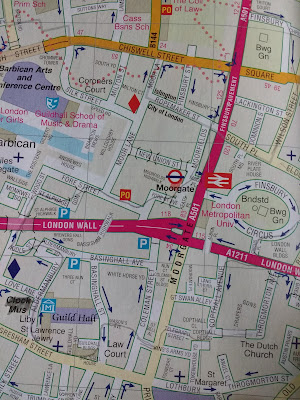
I feel like you covered an immense area. How did you keep all that information straight? And what a mixture of architectural styles and history! How many more stops do you have to go?
ReplyDeleteAnother amazing tour. It felt like you had walked miles!
ReplyDeleteWhat an interesting area. Among all the ornate building work, the lighthouse is delightfully simple. I like it.
ReplyDelete"The statues are named: Confidence, Prudence, Justice, Truth, Thrift and Self-denial." If your banks are anything like ours, only the first quality applies.
Always good to see some Roman wall.
Oh dear, a jury found someone not guilty of treason and the verdict was deemed to be unacceptable and so the jury was sent to gaol.
I have to wonder about the cattle trough, maybe she was a keen farmer.
ReplyDeleteSo very much of interest! Enlarged the sign about those tried and thought should have read that before Halloween .. yeek. Als dscovered through that process of embiggining that pic that there is the slide show capability on your blog -- I love that -- you might want to let your readers know about that; such a great feature for a blog like yours. Anyway --- loved the four statues and don't think most would be appropriate for any bank I know . Sad history at the begninning of the post about this accident and I expect if/when you publish these posts in book form the rails would hate to have that part included -- probably that (bad publicity) is why it took so long for the memorial. Loved every bit of the walk along the path connecting the pocket gardens. ... It must have been great to be QEI... she didn't like copper coins, ergo there were no copper coins. oh the things i would banish!!!
ReplyDeleteSo much history and interesting buildings in this area. Reading your blog teaches me so much about London that I didn't learn from my visits. The walkway looks fabulous.
ReplyDeleteSo much history around this stop ! Very interesting post !
ReplyDeleteHistoric, jam packed post. Glad I wasn't on that train. I love the nude, muscular sculptures.
ReplyDeleteHello, what an action packed post. The buildings and statues are beautiful. I love the stained glass. The train accident was tragic, such a terrible loss of lives. Thanks for sharing this tour and your photos are great. Enjoy your day, have a great new week!
ReplyDeleteVery informative and a reminder to this California resident that tragedy is nothing new.
ReplyDeleteYou do wonderful photography of the city of London ~ thoroughly enjoy your photo tour ~ almost like being there ~ thanks,
ReplyDeleteHappy Veterans Day
A ShutterBug Explores,
aka (A Creative Harbor)
Oh, I really like Gog and Magog. What a vast amount of information you've gathered on your many travels. I think you have enough data to fill a detailed history book one day. :)
ReplyDeleteMoorgate is a delight - another adventure of history and beauty. Thanks for sharing!
ReplyDeleteThe architecture is beautiful.
ReplyDeleteWorth a Thousand Words
Such imposing structures. And the details on them are so artistic.
ReplyDeleteThank you for the tour. :)
I can't believe you found so much in such a relatively small area. From here, your walk seemed like a marathon, but thank you for including so much detail and so many photos. I remember Moorgate. it was a very tragic but also frightening thing to happen.
ReplyDeleteWow - a lot of very impressive buildings in the area!
ReplyDelete